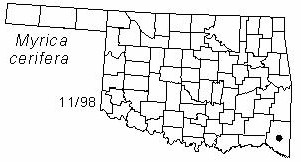Evergreen shrub or small tree to 12 m (40 ft) in height. Bark gray or gray-green. Twigs red-brown to gray with orange glands on young stems. Leaves alternate, simple; oblanceolate to elliptic, 3.8-13 cm (1.5 to 5 in) long, 6-18 mm (1/4-3/4 in) wide; lustrous above, with orange, resinous glands beneath; acute or rounded at apex; cuneate at base; margins entire or serrate; petiole short and stout. Inflorescence a catkin; flowers bisexual; stigmas 2; stamens 2-8, yellow; flowers appear from March to April. Fruit a drupe, about 3 mm (1/8 in) in diameter, globose; light green and covered with blue-green waxy granules; fruits mature in September to October.
Distribution: Eastern Texas, east to Florida, north to New Jersey. In Oklahoma restricted to southeastern McCurtain County.
Habitat: moist, sandy soils.
Comments: Myrica is the classical name for tamarisk (an unrelated tree); cerifera refers to the waxy fruits.
Horticulture: a popular ornamental that first entered cultivation in 1699. Wax-mrytle can be propagated by seeds, cuttings, and layering.
Economic value: pioneers extracted wax for candles by boiling the fruits.
Wildlife benefits: the fruits are eaten by about 40 species of birds.
NWI status: FAC,FACW
Distribution in Oklahoma: 
BACK
NEXT
RETURN TO INDEX
Last update: 9/14/99
 Go to Oklahoma Biological Survey Home Page
Go to Oklahoma Biological Survey Home Page
 Disclaimer
Disclaimer